Family Name: Cannabaceae Martinov
Synonym(s): Celtidaceae Engl.; Lupulaceae Schultz Sch., nom. illeg.
Common Name(s): hemp family
*Number of genera/species: 8/100
List of genera records in GRIN-Global
Fruit an acheneachene:
a dry, indehiscent, one-seeded fruit, with seed attached to pericarp at a single point, derived from a single, superior, simple or compound, one-loculed ovary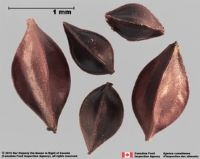 (Cannabis, Humulus) or drupedrupe:
(Cannabis, Humulus) or drupedrupe:
(indehiscent drupe) a fleshy, indehiscent fruit with one more hard pits enclosing seeds, derived from single, superior, simple or compound ovary; (dehiscent drupe) a fruit with a dry or fibrous to fleshy or leathery outer husk that early to tardily breaks apart (or opens), exposing one or more nutlike pits enclosing the seeds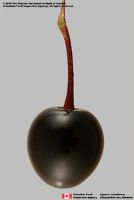 , 1.5–50 mm, ovoidovoid:
, 1.5–50 mm, ovoidovoid:
3D shape—ovate to globoseglobose:
to globoseglobose:
3D shape—more or less spherical , tereteterete:
, tereteterete:
approximately circular in cross section; width and thickness approximately equal
 to flattened in transection, usually unwinged (except in Pteroceltis, which has a pair of broad, woodywoody:
to flattened in transection, usually unwinged (except in Pteroceltis, which has a pair of broad, woodywoody:
texture—consisting mainly of indurate lignified tissues, characteristic of or resembling wood
, rounded wings), with one seed, enclosed by perianthperianth:
collective term for calyx and corolla of a flower
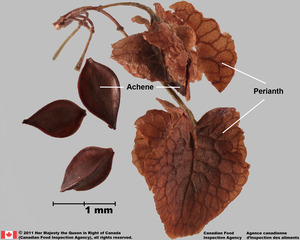 . Pericarppericarp:
. Pericarppericarp:
fruit wall or fruit coat
glabrousglabrous:
without hairs
or pubescentpubescent:
surface relief—bearing hairs
.
AchenesAchene:
a dry, indehiscent, one-seeded fruit, with seed attached to pericarp at a single point, derived from a single, superior, simple or compound, one-loculed ovary surrounded by one or two persistent bracts in addition to enclosed within perianthperianth:
surrounded by one or two persistent bracts in addition to enclosed within perianthperianth:
collective term for calyx and corolla of a flower
 . Pericarppericarp:
. Pericarppericarp:
fruit wall or fruit coat
white, yellow, green, brown, shinyshiny:
uniformly reflecting a high proportion of incident light at all angles (Cannabis), crustaceouscrustaceous:
(Cannabis), crustaceouscrustaceous:
texture—thin, dry, indurate, and brittle
, and finely reticulatereticulate:
surface relief—netted, raised walls or concave grooves forming a net-like surface pattern with flat, concave, or convex interspaces (Cannabis). Humulus achenesachene:
(Cannabis). Humulus achenesachene:
a dry, indehiscent, one-seeded fruit, with seed attached to pericarp at a single point, derived from a single, superior, simple or compound, one-loculed ovary aggerated in cone-like structure, each enclosed in brownish or mottledmottled:
aggerated in cone-like structure, each enclosed in brownish or mottledmottled:
with colored spots, streaks, or blotches of a different color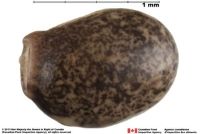 perianth, and usually included in bracts.
perianth, and usually included in bracts.
DrupesDrupe:
(indehiscent drupe) a fleshy, indehiscent fruit with one more hard pits enclosing seeds, derived from single, superior, simple or compound ovary; (dehiscent drupe) a fruit with a dry or fibrous to fleshy or leathery outer husk that early to tardily breaks apart (or opens), exposing one or more nutlike pits enclosing the seeds with persistent styles. Pericarp variously colored, dulldull:
with persistent styles. Pericarp variously colored, dulldull:
reflecting only a low proportion of incident light, with no apparent sheen , sometimes 3–5 angledangular:
, sometimes 3–5 angledangular:
2D shape—having sides that meet at acute or obtuse angles
, beakedbeak:
a usually firm, terminal appendage, sometimes tapered or not, and fleshy (fibrousfibrous:
or not, and fleshy (fibrousfibrous:
texture -- long, flexible threads, thicker than hairs, that densely cover and obscure the surface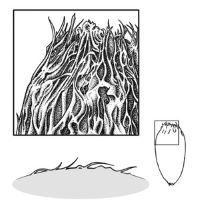 or succulentsucculent:
or succulentsucculent:
texture—herbaceous and juicy, often thickened
), rarely thin. Endocarpendocarp:
the inner layer of the pericarp, if divided into layers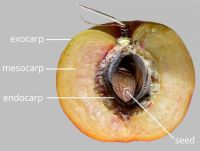 white, yellow, grayish brown, or reddish orange (Gironniera), 4–13 mm, and smooth or wrinkledwrinkled:
white, yellow, grayish brown, or reddish orange (Gironniera), 4–13 mm, and smooth or wrinkledwrinkled:
surface relief—shallow, irregular folds and furrows covering the surface; appearing overall though crumpled and then spread out or reticulately foveolate.
or reticulately foveolate.
Seeds globoseglobose:
3D shape—more or less spherical or oblongoblong:
or oblongoblong:
2D shape—much longer than broad with nearly parallel sides, corners are rounded , lens-shaped (achenesachene:
, lens-shaped (achenesachene:
a dry, indehiscent, one-seeded fruit, with seed attached to pericarp at a single point, derived from a single, superior, simple or compound, one-loculed ovary ) or tereteterete:
) or tereteterete:
approximately circular in cross section; width and thickness approximately equal
 or compressedcompressed:
or compressedcompressed:
flattened; in grasses, used to denote compression (not necessarily flattened) either laterally or dorsiventrally
(drupesdrupe:
(indehiscent drupe) a fleshy, indehiscent fruit with one more hard pits enclosing seeds, derived from single, superior, simple or compound ovary; (dehiscent drupe) a fruit with a dry or fibrous to fleshy or leathery outer husk that early to tardily breaks apart (or opens), exposing one or more nutlike pits enclosing the seeds ) in transection, similar in length to fruit (achenesachene:
) in transection, similar in length to fruit (achenesachene:
a dry, indehiscent, one-seeded fruit, with seed attached to pericarp at a single point, derived from a single, superior, simple or compound, one-loculed ovary ) or endocarpendocarp:
) or endocarpendocarp:
the inner layer of the pericarp, if divided into layers (drupesdrupe:
(drupesdrupe:
(indehiscent drupe) a fleshy, indehiscent fruit with one more hard pits enclosing seeds, derived from single, superior, simple or compound ovary; (dehiscent drupe) a fruit with a dry or fibrous to fleshy or leathery outer husk that early to tardily breaks apart (or opens), exposing one or more nutlike pits enclosing the seeds ). In achenesachene:
). In achenesachene:
a dry, indehiscent, one-seeded fruit, with seed attached to pericarp at a single point, derived from a single, superior, simple or compound, one-loculed ovary , seed coats adnate to pericarps. In drupesdrupe:
, seed coats adnate to pericarps. In drupesdrupe:
(indehiscent drupe) a fleshy, indehiscent fruit with one more hard pits enclosing seeds, derived from single, superior, simple or compound ovary; (dehiscent drupe) a fruit with a dry or fibrous to fleshy or leathery outer husk that early to tardily breaks apart (or opens), exposing one or more nutlike pits enclosing the seeds , seed coats brown, membranousmembranous:
, seed coats brown, membranousmembranous:
texture—extremely thin, pliable, and fairly tough
, smooth or reticulatereticulate:
surface relief—netted, raised walls or concave grooves forming a net-like surface pattern with flat, concave, or convex interspaces .
.
Embryo well developed, nearly filling seed cavity, peripheralperipheral:
(of embryo) embryo is curved around the outer edge of the seed, near the seed coat
, foliatefoliate:
appearing leaf-like
. Humulus embryo flatly coiledcoiled:
(of embryo) linear embryo is very long and bent to form a coil whereby one end of the embryo is on the outside and the other end near the middle of the seed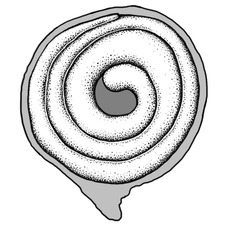 . Cannabis horseshoe-shaped. In drupesdrupe:
. Cannabis horseshoe-shaped. In drupesdrupe:
(indehiscent drupe) a fleshy, indehiscent fruit with one more hard pits enclosing seeds, derived from single, superior, simple or compound ovary; (dehiscent drupe) a fruit with a dry or fibrous to fleshy or leathery outer husk that early to tardily breaks apart (or opens), exposing one or more nutlike pits enclosing the seeds , embryos arcuate, bentbent:
, embryos arcuate, bentbent:
(of embryo) embryo is bent at an acute, V-shaped angle with the ends close together and generally thick cotyledons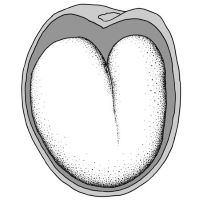 , or annularannular:
, or annularannular:
3D shape—forming a ring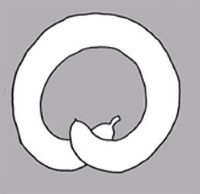 and cotyledons spatulatespatulate:
and cotyledons spatulatespatulate:
2D shape—like a spatula; rounded at the apex, with base long and tapered; (of embryo) embryo is straight and axile and centric with the cotyledons expanded to form the shape of a spatula or spoon; (of cotyledons) cotyledons expanded and wider than the stalk but not invested into the stalk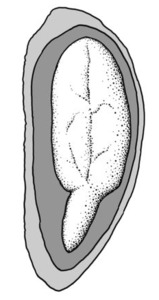 or investinginvesting:
or investinginvesting:
(of embryo) embryo is nearly or completely filling seed coat, straight, and axile and centric with spatulate cotyledons and covering the stalk for at least half its length; (of cotyledons) cotyledons spatulate and covering the stalk for at least half its length
and variously folded. In achenesachene:
a dry, indehiscent, one-seeded fruit, with seed attached to pericarp at a single point, derived from a single, superior, simple or compound, one-loculed ovary , cotyledons circinatecircinate:
, cotyledons circinatecircinate:
3D shape—terete and rolled downward from the apex in a tight coil
or convoluted.
Endosperm scanty, fleshy.
| Fruit | |
| Type | acheneachene: a dry, indehiscent, one-seeded fruit, with seed attached to pericarp at a single point, derived from a single, superior, simple or compound, one-loculed ovary  , drupedrupe: , drupedrupe:(indehiscent drupe) a fleshy, indehiscent fruit with one more hard pits enclosing seeds, derived from single, superior, simple or compound ovary; (dehiscent drupe) a fruit with a dry or fibrous to fleshy or leathery outer husk that early to tardily breaks apart (or opens), exposing one or more nutlike pits enclosing the seeds  |
| Size range | 1.5–50 mm long |
| Shape(s) | ellipticelliptic: 2D shape—oval, oblong-like with the 2 ends narrowing and more or less alike 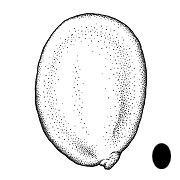 , ovoidovoid: , ovoidovoid:3D shape—ovate  , lenticularlenticular: , lenticularlenticular:3D shape—lens-shaped; biconvex 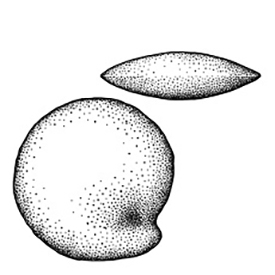 , globoseglobose: , globoseglobose:3D shape—more or less spherical  |
| Texture | acheneachene: a dry, indehiscent, one-seeded fruit, with seed attached to pericarp at a single point, derived from a single, superior, simple or compound, one-loculed ovary  - crustaceouscrustaceous: - crustaceouscrustaceous:texture—thin, dry, indurate, and brittle drupe - fleshy to thin |
| Surface relief | acheneachene: a dry, indehiscent, one-seeded fruit, with seed attached to pericarp at a single point, derived from a single, superior, simple or compound, one-loculed ovary  - reticulatereticulate: - reticulatereticulate:surface relief—netted, raised walls or concave grooves forming a net-like surface pattern with flat, concave, or convex interspaces  veined (Cannabis) veined (Cannabis)drupe - smooth, sometimes wrinkledwrinkled: surface relief—shallow, irregular folds and furrows covering the surface; appearing overall though crumpled and then spread out  or lenticellate or lenticellate |
| Color(s) | acheneachene: a dry, indehiscent, one-seeded fruit, with seed attached to pericarp at a single point, derived from a single, superior, simple or compound, one-loculed ovary  - white, yellow, green, brown - white, yellow, green, browndrupe - green, yellow, orange, red, reddish brown, brown, purplish black, black |
| Unique features |
Small brown or yellowish, shinyshiny: Or, small, variously colored, dulldull: |
| Seed | |
| Size range | similar in size to fruit (acheneachene: a dry, indehiscent, one-seeded fruit, with seed attached to pericarp at a single point, derived from a single, superior, simple or compound, one-loculed ovary  ) or endocarpendocarp: ) or endocarpendocarp:the inner layer of the pericarp, if divided into layers  (drupedrupe: (drupedrupe:(indehiscent drupe) a fleshy, indehiscent fruit with one more hard pits enclosing seeds, derived from single, superior, simple or compound ovary; (dehiscent drupe) a fruit with a dry or fibrous to fleshy or leathery outer husk that early to tardily breaks apart (or opens), exposing one or more nutlike pits enclosing the seeds  ) ) |
| Shape(s) | globoseglobose: 3D shape—more or less spherical  , oblongoblong: , oblongoblong:2D shape—much longer than broad with nearly parallel sides, corners are rounded  |
| Surface relief | smooth, reticulatereticulate: surface relief—netted, raised walls or concave grooves forming a net-like surface pattern with flat, concave, or convex interspaces  |
| Color(s) | brown |
| Unique features | In drupesdrupe: (indehiscent drupe) a fleshy, indehiscent fruit with one more hard pits enclosing seeds, derived from single, superior, simple or compound ovary; (dehiscent drupe) a fruit with a dry or fibrous to fleshy or leathery outer husk that early to tardily breaks apart (or opens), exposing one or more nutlike pits enclosing the seeds  , bonybony: , bonybony:very hard and rather brittle, like bone endocarps hold a single seed with a curvedcurved: (of embryo) linear embryo is curved into an arch or horseshoe with the ends far apart  embryo and scant endosperm. embryo and scant endosperm. |
| Other | |
| Embryo | well developed, nearly filling seed cavity, peripheralperipheral: (of embryo) embryo is curved around the outer edge of the seed, near the seed coat , foliatefoliate: appearing leaf-like , arcuate, bentbent: (of embryo) embryo is bent at an acute, V-shaped angle with the ends close together and generally thick cotyledons  , horseshoe-shapedhorseshoe-shaped: , horseshoe-shapedhorseshoe-shaped:3D shape—relatively slender and strongly compressed, the whole strongly curved over its length in a plane perpendicular to the direction of compression and forming an incomplete circle, the ends somewhat straighter than the rest and parallel or nearly so 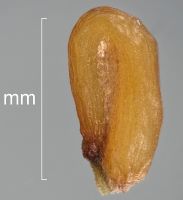 , or annularannular: , or annularannular:3D shape—forming a ring  , cotyledons folded to circinatecircinate: , cotyledons folded to circinatecircinate:3D shape—terete and rolled downward from the apex in a tight coil |
| Nutritive tissue | endosperm scanty, fleshy |
Temperate and tropical regions worldwide

Distribution map courtesy of Angiosperm Phylogeny Website.
Backer 1951Backer 1951:
Backer CA. 1951. Cannabaceae. Flora Malesiana. Ser. 1, Spermatophyta 4(3): 222–224. https://www.biodiversitylibrary.org/page/40229357 ; Bingham et al. 2021+Bingham et al. 2021+:
Bingham MG, Willeman A, Wursten BT, Ballings P, and Hyde MA. 2021. Flora of Zambia. Accessed January 2021–April 2024. URL: https://www.zambiaflora.com; Flora of North America Editorial Committee 1993+Flora of North America Editorial Committee 1993+:
Flora of North America Editorial Committee, eds. 1993+. Flora of North America North of Mexico [Online]. 22+ vols. Flora of North America Association, New York and Oxford. Accessed January-March 2024. URL: http://beta.floranorthamerica.org.; Kirkbride et al. 2006Kirkbride et al. 2006:
Kirkbride JH, Jr, Gunn CR, and Dallwitz MJ. 2006. Family guide for fruits and seeds, vers. 1.0. Accessed September 2020-January 2022. URL: https://nt.ars-grin.gov/seedsfruits/keys/frsdfam/index.cfm .; Kubitzki et al. 1990+Kubitzki et al. 1990+:
Kubitzki K et al., eds. 1990+. The families and genera of vascular plants. 7+ vols. Berlin etc.; Nooteboom et al. 2021+Nooteboom et al. 2021+:
Nooteboom HP, de Wilde WJJO, Stevens PF, Coode MJE, and Saw LG. 2021+ Flora Malesiana Online. Accessed January 2021–March 2024. URL: https://portal.cybertaxonomy.org/flora-malesiana/; Takhtajan 2009Takhtajan 2009:
Takhtajan A. 2009. Flowering plants: Second edition. Springer Nature, Switzerland. 871 pp.; Tropicos.org 2021+Tropicos.org 2021+:
Tropicos.org. 2021+. Pakistan Plant Database. Missouri Botanical Garden. Accessed January 2021–April 2024. http://legacy.tropicos.org/Project/Pakistan; Tutin et al. 1964–1980Tutin et al. 1964–1980:
Tutin TG, Burges NA, Chater AO, Edmondson JR, Heywood VH, Moore DM, Valentine DH, Walters SM, and Webb DA (eds.) 1964–1980. Flora Europaea. 5 vols. Cambridge University Press, Cambridge UK. 2,524 pp.; Zhengyi et al. 2004+Zhengyi et al. 2004+:
Zhengyi W, Raven PH, and Deyuan H. 2004+. Flora of China [online]. 25 vols. Science Press, Beijing China & Missouri Botanical Garden, St. Louis USA. Accessed January–March 2024. http://flora.huh.harvard.edu/china/
*The number of genera and species is based on Christenhusz and Byng 2016Christenhusz and Byng 2016:
Christenhusz MJM and Byng JW. 2016. The number of known plant species in the world and its annual increase. Phytotaxa 261 (3): 201-217. https://doi.org/10.11646/phytotaxa.261.3.1, which may differ from the number of genera in GRIN-Global.